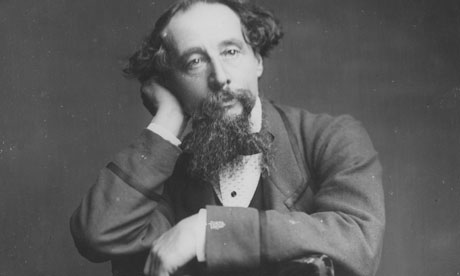Charles Dickens’ corpus of literary achievements established him as the preeminent author of Victorian England. Yet Dickens came from humble beginnings, and his first stories were published anonymously. His first signed work was published under the pseudonym “Boz,” a moniker which his colleague, illustrator Hablot Knight Browne, would echo in his own nom de guerre, “Phiz.”

The March 1837 issue of ‘Bentley’s Miscellany’ establishes that Dickens is indeed Boz. The issue also contains Browne’s first known sketch of Dickens.
Dickens the Inimitable
Dickens’ first piece of fiction, the sketch “Mr. Minns and His Cousin” (originally “A Dinner at Poplar Park”) appeared in The Monthly Magazine in December, 1833. Dickens continued to place his pieces in various periodicals, but it wasn’t until 1834 that any of the works bore a name. “The Boarding House” bore the name “Boz” when it appeared in The Monthly Magazine that August. In March 1837, Dickens was officially “outed” as Boz with a bit of doggerel in Bentley’s Miscellany:
“Who the dickens ‘Boz’ could be
Puzzled many a learned elf,
Till Time unveiled the mystery,
And ‘Boz’ appeared as Dickens’ self
The nickname itself has a rather odd provenance. Dickens had nicknamed his younger brother Moses, after a character in Oliver Goldsmith’s Vicar of Wakefield. When pronounced through the nose, “Moses” sounds like “Boses,” which Dickens shortened to “Boz.” He was often referred to as “the inimitable Boz,” but the last word eventually fell away, and Dickens was henceforth known only as “the Inimitable.”
Enter Phiz

Dickens published ‘Sunday under Three Heads’ under the pseudonym Timothy Sparks. He defended the working man’s rights on the Sabbath, which were under attack by Parliament at the time.
By the spring of 1836, Dickens was searching for a new illustrator for Pickwick Papers. He commissioned a small pamphlet from Hablot Knight Browne entitled Sunday under Three Heads, and the two collaborated well together. Thus Browne sought further work from the author. Both Browne and William Makepeace Thackeray offered sample sketches for Dicken’s review, and Dickens chose Browne.
Browne initially used the name NEMO, Latin for “nobody” as his pseudonym. But he soon began using “Phiz” instead, which was appropriate for someone responsible for creating phizzes, that is, delightful and lighthearted caricatures. By the time the parts issue of Pickwick Papers was complete, Dickens, notoriously opinionated with respect to his illustrations, had found “his” illustrator. He became quite friendly with Browne, who even traveled with Dickens while he researched Nicholas Nickleby.
Browne would go on to illustrate ten of Dickens’ fifteen novels, notably David Copperfield and Martin Chuzzlewit. But before the publication of Tale of Two Cities, Dickens suddenly cut off Browne. Perhaps Dickens knew that Browne’s work was no longer fashionable. Browne, upset that Dickens refused to elucidate his complaint against Browne, conjectured in a letter to his assistant Robert Young, “Dickens probably thinks a new hand would give his puppets a fresh look, or perhaps he doesn’t like my illustrating Trollope neck-and-neck with him–though, by Jingo, he need have no rivalry there! Confound all authors and publishers, I say. There’s no pleasing on or t’other.”
Though Dickens would go on to work with many other illustrators–and had indeed worked with other illustrators even during Browne’s tenure–the works of Phiz remain most closely associated with Dickens’ novels. New illustrations were chosen for Tale of Two Cities, but Phiz’s plates are still the ones most often chosen to accompany the text in later editions.


